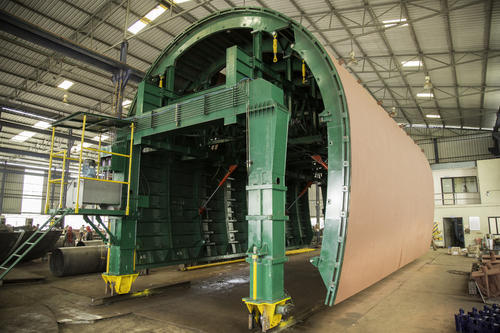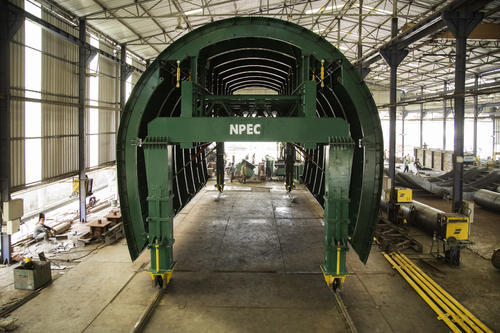Table of Contents
Enhancing Railway Infrastructure: The Innovation of the 3-Line Tunnel Gantry
Railway infrastructure serves as the cornerstone of transportation networks worldwide, providing a crucial link for the efficient movement of goods and passengers. However, with the relentless growth of populations and urbanization, the pressure on existing railway systems has intensified, necessitating innovative solutions to address capacity constraints, enhance safety, and improve overall efficiency. In response to these challenges, the introduction of the 3-Line Tunnel Gantry emerges as a groundbreaking advancement in railway engineering, poised to revolutionize the way railway infrastructure is designed and operated.

The concept of the 3-Line Tunnel Gantry represents a paradigm shift in traditional tunnel design, offering a transformative solution to optimize tunnel capacity and utilization. Unlike conventional tunnel structures which typically accommodate a single railway track, the 3-Line Tunnel Gantry is ingeniously engineered to house three parallel railway lines within a single tunnel structure. This innovative design not only maximizes the utilization of available space but also minimizes the environmental footprint associated with constructing multiple tunnels, making it an economically and environmentally sustainable solution.

At the heart of the 3-Line Tunnel Gantry lies a meticulously engineered design that seamlessly integrates with existing railway networks while offering a host of benefits. The gantry comprises robust support structures, advanced track systems, state-of-the-art signalling mechanisms, and comprehensive safety features, ensuring smooth and efficient operation under diverse operating conditions. By accommodating three railway lines within a single tunnel, the gantry significantly enhances capacity, enabling more frequent train services, reducing congestion, and improving overall network efficiency.
Moreover, the streamlined design of the 3-Line Tunnel Gantry translates into cost savings in terms of construction expenses and long-term maintenance, offering a compelling value proposition for railway operators and infrastructure developers. By minimizing the need for extensive excavation and land acquisition, the gantry also mitigates environmental impact, preserving natural habitats and ecosystems while contributing to sustainable development goals.

The versatility of the 3-Line Tunnel Gantry extends beyond its capacity-enhancing capabilities, finding applications across a wide range of railway infrastructure projects. In urban rail networks, where space constraints and high demand pose significant challenges, the gantry offers a viable solution to optimize capacity and alleviate congestion. In high-speed rail projects, the gantry enables the integration of multiple tracks within a single tunnel, facilitating faster travel times and increased train frequencies, thereby enhancing connectivity and accessibility for passengers.
Furthermore, international examples of successful implementations of the 3-Line Tunnel Gantry in countries such as Japan, China, and various European nations underscore its effectiveness in enhancing railway infrastructure on a global scale. These case studies serve as compelling testimonials to the transformative impact of the gantry on railway operations, underscoring its potential to revolutionize the way railway infrastructure is designed, constructed, and operated worldwide.

The innovation of the 3-Line Tunnel Gantry represents a significant milestone in the evolution of railway infrastructure, offering a sustainable, efficient, and cost-effective solution to address the growing demand for transportation services. By maximizing tunnel capacity, enhancing operational efficiency, and minimizing environmental impact, the gantry epitomizes the potential of engineering ingenuity to shape the future of transportation. As railway systems continue to evolve to meet the needs of a rapidly changing world, the 3-Line Tunnel Gantry stands as a testament to the power of innovation in driving progress and connectivity for generations to come.
NPEC: Pioneering Fabrication of Railway 3-Line Tunnel Gantry
NPEC (National Power Engineering Company) stands at the forefront of innovation in railway infrastructure, specializing in the fabrication of cutting-edge 3-line Tunnel Gantry. With a commitment to excellence and a track record of delivering high-quality solutions, NPEC has emerged as a leading fabricator in the railway industry. This article explores NPEC’s expertise in the fabrication of the 3-Line Tunnel Gantry and its contributions to enhancing railway infrastructure worldwide.
Expertise in Fabrication:
NPEC boasts a team of skilled engineers, technicians, and fabricators with extensive experience in precision engineering and metal fabrication. Leveraging state-of-the-art technologies and advanced manufacturing processes, NPEC ensures the highest standards of quality and reliability in every aspect of gantry fabrication.
Innovative Design Solutions:
Collaborating closely with railway authorities, consultants, and engineering firms, NPEC develops innovative design solutions tailored to the specific requirements of each project. The 3-Line Tunnel Gantry is meticulously designed to optimize tunnel capacity, minimize environmental impact, and enhance operational efficiency, setting new benchmarks in railway infrastructure.
Precision Manufacturing:
At NPEC’s advanced fabrication facilities, precision is paramount. Utilizing CNC (Computer Numerical Control) machining, laser cutting, and robotic welding technologies, NPEC manufactures gantry components with unparalleled accuracy and consistency. Rigorous quality control measures ensure that each component meets exacting specifications, guaranteeing the structural integrity and reliability of the finished gantry.
Quality Assurance:
NPEC is committed to delivering products of the highest quality, adhering to international standards and best practices. Stringent quality assurance protocols are implemented throughout the fabrication process, from material selection to final inspection. Comprehensive testing and validation procedures validate the performance and durability of the 3-Line Tunnel Gantry, instilling confidence in its reliability and safety.
Timely Delivery:
Recognizing the importance of timely project delivery, NPEC employs efficient production scheduling and project management methodologies to meet project deadlines without compromising quality. With streamlined workflows and optimized logistics, NPEC ensures on-time delivery of gantry components to construction sites, facilitating seamless integration into railway infrastructure projects.
Global Reach:
NPEC’s reputation for excellence extends globally, with a diverse portfolio of successful projects spanning across continents. From urban rail networks to high-speed rail corridors, NPEC’s 3-Line Tunnel Gantry has been instrumental in enhancing railway infrastructure and improving transportation connectivity worldwide. Collaborating with international partners and stakeholders, NPEC continues to contribute to the advancement of railway systems on a global scale.

As a leading fabricator of the railway 3-Line Tunnel Gantry, NPEC epitomizes excellence in precision engineering and manufacturing. With a relentless focus on quality, innovation, and customer satisfaction, NPEC continues to shape the future of railway infrastructure, delivering solutions that drive efficiency, sustainability, and progress. With NPEC’s expertise and dedication, the vision of a modern, interconnected railway network becomes a reality, benefiting communities and economies around the world.
1. Understanding the Need for Innovation in Railway Infrastructure:
1.1 Growth in Urbanization and Population: With rapid urbanization, cities face congestion and transportation challenges, emphasizing the need for efficient railway systems.
1.2 Increasing Demand for Railway Transportation: The demand for railway transportation continues to rise due to its environmental sustainability, cost-effectiveness, and capacity to move large volumes of freight and passengers.
1.3 Challenges in Existing Railway Infrastructure: Aging infrastructure, capacity constraints, and safety concerns highlight the necessity for innovative solutions to modernize railway networks.
2. Introducing the 3-Line Tunnel Gantry:
2.1 Definition and Concept: The 3-Line Tunnel Gantry refers to a specialized infrastructure designed to optimize railway tunnel capacity by accommodating three parallel railway lines within a single tunnel structure.
2.2 Design and Components: The gantry comprises robust support structures, track systems, signalling mechanisms, and safety features to ensure seamless operation and passenger safety.

2.3 Advantages over Traditional Tunnel Structures: By utilizing the available space more efficiently, the 3-Line Tunnel Gantry increases capacity, reduces construction costs, and minimizes environmental impact compared to conventional tunnel designs.
3. Engineering and Construction Considerations:
3.1 Geotechnical Analysis: Thorough geotechnical surveys and analyses are conducted to assess soil conditions, rock formations, and groundwater levels to inform the tunnel design and construction process.
3.2 Structural Design: Engineers employ advanced modelling techniques and simulations to optimize the gantry’s structural integrity, considering factors such as tunnel depth, ground stability, and seismic activity.

3.3 Construction Methodology: Innovative construction methods, including tunnel boring machines (TBMs), cut-and-cover techniques, and precast segmental lining, are utilized to expedite the construction process while minimizing disruptions to existing railway operations.
4. Benefits of Implementing the 3-Line Tunnel Gantry:
4.1 Increased Capacity: By accommodating three railway lines within a single tunnel, the gantry significantly enhances railway network capacity, allowing for more frequent train services and reduced congestion.
4.2 Improved Operational Efficiency: The streamlined design of the gantry facilitates smoother train movements, reduces travel times, and enhances overall operational efficiency.

4.3 Cost-Effectiveness: Compared to constructing multiple separate tunnels, the 3-Line Tunnel Gantry offers cost savings in terms of both construction expenses and long-term maintenance.
4.4 Environmental Sustainability: By minimizing land use and reducing the need for extensive excavation, the gantry helps mitigate environmental impact, preserving natural habitats and ecosystems.
5. Applications and Case Studies:
5.1 Urban Rail Networks: The 3-Line Tunnel Gantry finds extensive application in urban rail networks, where space constraints and high demand necessitate innovative solutions to optimize capacity and efficiency.
5.2 High-Speed Rail Projects: In high-speed rail projects, the gantry enables the integration of multiple tracks within a single tunnel, facilitating faster travel times and increased train frequencies.
6. Future Prospects and Challenges:
6.1 Technological Advancements: Continued advancements in materials science, construction techniques, and railway signalling systems hold the potential for further optimization and refinement of the 3-Line Tunnel Gantry.
6.2 Regulatory and Policy Considerations: Regulatory frameworks and government policies play a crucial role in promoting the adoption of innovative railway infrastructure solutions and addressing safety and environmental concerns.

6.3 Addressing Emerging Challenges: Anticipating future challenges such as climate change, population growth, and evolving transportation needs, engineers and policymakers must collaborate to develop resilient and sustainable railway systems.
The introduction of the 3-Line Tunnel Gantry marks a significant milestone in the advancement of railway infrastructure, presenting an innovative and efficient solution to meet the ever-growing demand for transportation services. This engineering marvel not only maximizes the capacity of railway tunnels but also enhances operational efficiency, contributing to the development of resilient and sustainable railway networks capable of serving future generations.
The 3-Line Tunnel Gantry is a testament to the power of innovation in addressing the challenges faced by modern transportation systems. By accommodating three parallel railway lines within a single tunnel structure, the gantry optimizes the utilization of available space, thereby maximizing tunnel capacity. This means that more trains can pass through the tunnel simultaneously, leading to reduced congestion and smoother traffic flow. Additionally, the streamlined design of the gantry enhances operational efficiency, resulting in shorter travel times and improved overall performance of the railway network.

Embracing such innovative solutions underscores the importance of continuous investment in research, technology, and infrastructure development. It reflects a proactive approach towards ensuring the viability and sustainability of transportation systems worldwide. By adopting transformative technologies like the 3-Line Tunnel Gantry, stakeholders in the transportation sector demonstrate their commitment to driving progress and meeting the evolving needs of communities.
Furthermore, the implementation of the 3-Line Tunnel Gantry has far-reaching implications for the future of railway infrastructure. Not only does it address the immediate challenges of capacity constraints and operational inefficiencies, but it also lays the foundation for the development of robust and resilient railway networks capable of withstanding the demands of the future. This is particularly crucial in the face of rapid urbanization and population growth, which are expected to further intensify the pressure on transportation systems in the years to come.

Moreover, the adoption of innovative solutions like the 3-Line Tunnel Gantry can have significant environmental benefits. By maximizing the capacity of existing infrastructure, the gantry minimizes the need for additional construction, thereby reducing the environmental footprint associated with railway expansion projects. Additionally, the improved operational efficiency of the railway network leads to reduced energy consumption and greenhouse gas emissions, further contributing to environmental sustainability.

The introduction of the 3-Line Tunnel Gantry represents a transformative leap forward in the evolution of railway infrastructure. By addressing capacity constraints, enhancing operational efficiency, and promoting environmental sustainability, this innovative engineering solution paves the way for the development of resilient and sustainable transportation systems capable of meeting the needs of future generations. Embracing such innovations underscores the importance of continuous investment in research, technology, and infrastructure development to ensure the viability and sustainability of transportation systems worldwide.
